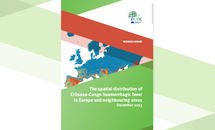The spatial distribution of Crimean-Congo haemorrhagic fever in Europe and neighbouring areas
This report provides updated baseline data for monitoring future changes in the distribution of autochthonous Crimean-Congo haemorrhagic fever and its associated vectors for Europe and its neighbouring areas.
Executive Summary
Crimean-Congo haemorrhagic fever (CCHF) is a tick-borne viral (Nairovirus , family Bunyaviridae) infection first identified in the Crimean region in 1944. It is one of the most widely distributed arboviral diseases in the world, ranging from southern Russia and the Black Sea region to the southern tip of Africa. The disease is considered as ‘emerging’ across the globe, with many countries reporting new CCHF cases in humans in recent decades, including Georgia, Türkiye, Albania and, most recently, Spain.
The distribution of CCHF was modelled globally in 2015 by Messina et al and in 2020 by Okely et al through ecological niche modelling, a technique which uses statistical correlations of presence and absence data with environmental variables such as temperature and landcover to spatially predict the ecological suitability (i.e. the
probability of presence and absence) for the species or disease of interest in an area. Messina et al. predicted high probability areas for autochthonous disease to be in parts of eastern and southern Europe. It also predicted high ecological suitability for CCHF in areas of Spain, which was, however, hidden from view (masked) in the published distribution as the disease had then yet to be found in Iberia. The 2015 model also did not take into account the likely distributions of its main tick vectors in Europe, namely Hyalomma marginatum and H. lusitanicum. The Okely et al. study showed updated risk areas which included Spain, and also statistically compared the distribution of environments assessed as ecologically suitable for autochthonous acquisition of CCHF human disease to that of the primary tick vectors. Still, these vector distributions were not used to modify or mask (by hiding areas predicted to be environmentally suitable from view where the vectors are not present) the maps depicting environments assessed as ecologically suitable for autochthonous acquisition of human CCHF.
ECDC therefore asked that the 2015 modelled distributions of likely areas for autochthonous acquisition of CCHF for Europe and its neighbouring areas be re-estimated and updated, taking into account both the recent disease occurrence data and the distribution of its vectors. Two sets of spatial modelling were performed, both using a common covariate predictor data suite and long-established spatial modelling techniques. These models were a) for CCHF itself using Boosted Regression Trees (BRT), as used in 2015, and trained on presence data extracted from the published literature and statistically assigned pseudo-absence data, and b) for the two vector species
using an ensemble of Random Forest and Boosted Regression Tree models, trained on presence data provided by the ECDC VectorNet project, other online databases and absence data based on calculated habitat suitability.
As the CCHF occurrence in Europe is too limited to establish reliable statistical correlations between CCHF presence and absence data in Europe and environmental covariates, the global distribution of the disease – including Europe, Africa, and Asia – was modelled, based on the assumption that a global model better informs a predicted distribution for Europe and its neighbouring areas.
The resulting model suggests substantially more areas with ecological suitability for autochthonous CCHF in Europe and its neighbouring areas than did the 2015 model, largely because more disease records were found in Albania, Greece, Spain, and Western Asia. The environmental suitability for autochthonous acquisition of the disease extends into much of northern Europe and the northern Caucasus – significantly beyond the vector distributions, which at worst restrict its northern range to about 49oN (latitude of Paris, France).
The vector distribution models allow for refined mapping of areas of ecological suitability for autochthonous acquisition of CCHF compared to 2015 (where entire countries were masked out) by hiding (only) those areas in the basic CCHF spatial model from view (i.e. masking) where no vectors are present. When using the minimum predicted vector distribution as the mask, hiding a larger area with CCHF predicted suitability from view, much of the Mediterranean seaboard, the Balkans along with Türkiye and the Caucasus are predicted to be have patches suitable for CCHF. However, using the maximum predicted vector distribution as a mask, the resulting CCHF ecological suitability map matches the observed disease occurrences most closely, and on that map, the predicted suitability for CCHF extends significantly further north into parts of central France and eastward into central Europe.
This suggests that a number of countries that have yet to record CCHF may benefit from paying attention to this risk – especially those with Mediterranean coastlines. In comparison to the (masked) 2015 model, while much of Europe’s ecological suitability for CCHF remains similar in this updated model, several subnational regions show increased ecological suitability for CCHF, particularly pockets throughout France, Italy, Spain, the Balkans, and the Caucasus.







